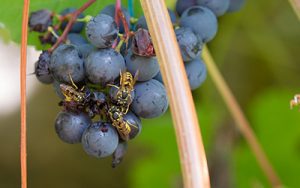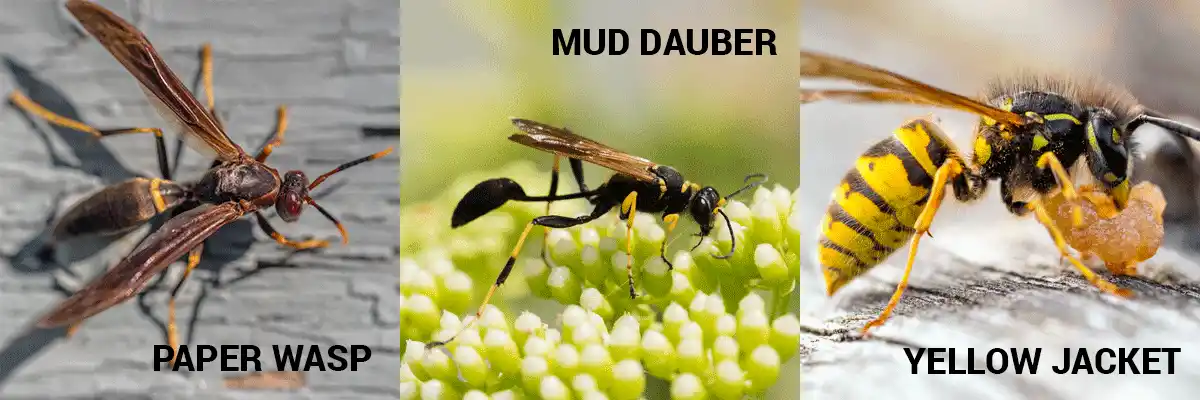How to Tell Wasps, Hornets, and Yellow Jackets Apart
Serving Atlanta Metro | Columbus | Augusta | Savannah

Summertime fun means spending time outside, and whether you’re hanging out at the pool, going for a hike, or hosting a backyard barbecue, nothing raises the anxiety level quite like the sudden appearance of stinging insects. When these uninvited guests crash the party, what should you do next? First, do what you have to do to avoid getting stung – and make sure children, the elderly, and anyone who might be sensitive is safe, too. Next, try to determine which kind of stinging insect you’re dealing with.
Let’s talk about the types of stinging insects you’re likely to encounter in Georgia, and how to tell wasps, hornets, and yellowjackets apart.
Common Stinging Insects in Georgia
Here are some different types of stinging insects you may find here:
- Bees – Bees are the best-case scenario for stinging insects. They are rarely aggressive, excellent pollinators that bring many benefits to your garden, and are easy to identify with their rounded, fuzzy bodies. There are a few different types of bees you may find including bumblebees and honey bees.
- Mud Daubers – Mud daubers build nests from mud. They are mostly black but may have light-colored markings, with a narrow waist. A type of solitary wasp, they aren’t aggressive and will only sting when directly handled.
- Paper Wasps – Known for the papery nests they build, often hanging from tree branches, porch ceilings, and door railings. Paper wasps aren’t as aggressive as yellowjackets, but they will sting to defend their nests. Their sting hurts.
- Yellow Jackets – An unofficial state mascot of Georgia and infamously aggressive, yellowjackets (or yellow jackets) live in colonies of up to or more than 1,000 workers. If yellow jackets feel threatened, they may sting repeatedly.
- Bald-Faced Hornet: Called a hornet but technically a yellowjacket, bald-faced hornets are fairly large, and often become a problem for humans due to their tendency to make their homes in wall cavities, attics, and structural openings. They are often recognized from the distinctive white markings on their face.
- European Hornet: The largest stinging and flying insect found in Georgia, the European hornet has a bright yellow appearance and looks very intimidating. They are highly aggressive and will sting multiple times if defending their nest.
Say Goodbye to Pest Problems for Good!
Ready for your FREE quote?
Fill out the form below and we’ll be in touch!
*During normal business hours. After hours inquiries will be returned the next business day.
What’s the Difference Between Wasps, Hornets, and Yellow Jackets?
Many people use “wasp,” “hornet,” and “yellowjacket” interchangeably, but there are some key differences. First of all, “wasp” is actually an order of insects, not a specific species. Yellowjackets, European hornets, mud daubers, and paper wasps are all types of wasps. One easy way to help determine if it’s a wasp is the common characteristic they share: a narrow waist. Notably, bees do not share this characteristic; they belong to a separate order.
If it has a narrow waist, you can usually conclude it’s a type of wasp. The next step is figuring out what type of wasp it is.
How to Tell Hornets and Yellowjackets Apart
Hornets and yellowjackets are two types of wasps; they’re similar in many ways, including their ability to quickly break up a cookout. However, there are some key ways you can tell hornets and yellowjackets apart:
- Appearance: Hornets and yellowjackets look different, but it’s tough to tell. Hornets are generally larger, but there’s only a slight difference, and when one is divebombing at you, you might not immediately notice if it’s 1 ¼” long as in the case of a hornet, or 1” like a yellowjacket. Hornets may appear in a few different colors other than yellow, such as white or orange.
- Nests: Finding the nest is the easiest way to tell what you’re dealing with. If you find a wooden or papery nest hanging off a tree or structure, it’s likely hornets. Whereas yellowjackets create burrows or ground nests.
- Aggressiveness: It’s generally said that yellowjackets are the most aggressive type of wasp. While this may be true, hornets can also become quite aggressive and sting people or pets if they believe their nest is threatened.
What Attracts Wasps, Hornets, and Yellowjackets?
Wasps, hornets, and yellowjackets are primarily driven by the need to gather food and water. Wasps are attracted to the smell of food and seem especially attracted to sugary and meaty-smelling foods. That’s one reason why wasps tend to interrupt human gatherings: because food is involved.
Summertime Wasp Control
Do you like stinging insects like bees and wasps? If so, Georgia is arguably the best place in the entire United States to live. If not, at least you can call Active Pest Control to take care of the problem. We have decades of experience serving greater Atlanta and the surrounding areas with highly effective bee, wasp, hornet, and yellowjacket control.
If it stings and you want it gone, we’ll take care of it. Call us today for a free estimate, or to schedule an appointment with an experienced technician.
Back to Bee, Wasp, & Hornet Exterminators, Control & Removal
How to Tell Wasps, Hornets, and Yellow Jackets Apart in Georgia
Serving Your Pest Needs for Over 35 Years Across Georgia
McDonough | Conyers | Lawrenceville | Alpharetta | Marietta | Columbus
Newnan | Locust Grove | Rome | Atlanta | Brunswick | Byron | Augusta | Savannah
Home » Bee, Wasp, & Hornet Exterminators, Control & Removal » How to Tell Wasps, Hornets, and Yellow Jackets Apart

